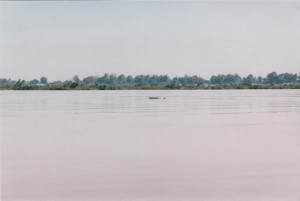[In January 2003 I accompanied an expedition that was conducting a survey of river dolphins on a stretch of the Mekong River in Cambodia. The expedition was led by Isabel Beasley, who was then a PhD student specializing on Orcaella brevirostris: also known as the ‘Irrawaddy Dolphin’ this species is found in many Asian river systems and deltas. The journal I kept during the expedition will appear on this site as a continuous series of posts. This is part 26 of the series.]
Do you ever wonder, I asked Isabel, what the world looks like to Orcaella?
Yes, she said, sometimes. Why for example did the dolphin that was caught in the tributary neglect (or refuse) to leave? Its echolocation must have told it that there was a way out: then why didn’t it leave? Was it afraid? But if it can experience a predictive fear then it makes you wonder what else it might be capable of experiencing.
Isabel has already surveyed the stretch of river between Kratie and the Laos border 8 times. This is the 9th. She’s done this survey with roughly the same teams but at different times of the year. The only time she hasn’t done it is in June-July, during the rainy season. This is because in that season it is simply not feasible – it rains a lot and the data sheets get wet. The river is almost un-navigable. But it seems to me that that is perhaps the most essential time of year.
 Isabel told me that Cambodians hate killing dolphins. There is an elaborate mythology of the dolphin: the story is that the dolphin came into being after a woman was swallowed by a python. The woman managed to extricate herself and went to the river to wash off the python’s mucus. The moment she touched the water she was transformed into a dolphin.
Isabel told me that Cambodians hate killing dolphins. There is an elaborate mythology of the dolphin: the story is that the dolphin came into being after a woman was swallowed by a python. The woman managed to extricate herself and went to the river to wash off the python’s mucus. The moment she touched the water she was transformed into a dolphin.
Isabel has often been told that Cambodians will not kill a dolphin on purpose. Usually if a dolphin is fouled in their nets they will set it free.
There is a belief that killing a dolphin brings bad luck. But I suspect thhat the story is a little more complicated. Today someone said that in the Pol-Pot-time ‘when everyone have gone’ people frequently shot dolphins.
But Isabel once came across a man who had killed a dolphin by mistake – it had gotten fouled in his net. He was sick with apprehension and had applied suction cups all over his body; he was convinced he was going to die.


